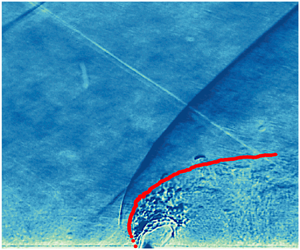Article contents
Turbulent mixing and trajectories of jets in a supersonic cross-flow with different injectants
Published online by Cambridge University Press: 01 February 2021
Abstract

We investigate flow fields and trajectories of sonic jets in a supersonic cross-flow with different injectant properties. The cross-flow is held at a fixed condition with Mach number 1.71, static temperature  $\sim$375 K and static pressure
$\sim$375 K and static pressure  $\sim$76 kPa. Jet conditions cover momentum flux ratios
$\sim$76 kPa. Jet conditions cover momentum flux ratios  $J$ from 1 to 6, molecular weights from
$J$ from 1 to 6, molecular weights from  $\sim$4 to 44 g mol
$\sim$4 to 44 g mol $^{-1}$ and specific heat ratios from
$^{-1}$ and specific heat ratios from  $\sim$1.24 to 1.66. Mie-scattering images are used to study turbulent mixing and trajectory development. Qualitative trends suggest that, at
$\sim$1.24 to 1.66. Mie-scattering images are used to study turbulent mixing and trajectory development. Qualitative trends suggest that, at  $J=4\text {--}6$, the convective Mach number concept applies as discussed in previous literature. At lower
$J=4\text {--}6$, the convective Mach number concept applies as discussed in previous literature. At lower  $J$, however, trends for changing molecular weights seem to reverse and the boundary layer might influence turbulent mixing. Analytically estimated jet velocities suggest the suppression of hydrodynamic instabilities changes at different rates for different injectants, as
$J$, however, trends for changing molecular weights seem to reverse and the boundary layer might influence turbulent mixing. Analytically estimated jet velocities suggest the suppression of hydrodynamic instabilities changes at different rates for different injectants, as  $J$ increases. A newly developed, semi-empirical jet trajectory scaling explicitly considers the momentum flux ratio, boundary layer effects and the existence of the jet bow shock. For validation, this scaling is applied to our trajectory data and those of existing literature, extending the covered parameter space. Quantifying the degree of trajectory correlation shows the scaling is specifically relevant at
$J$ increases. A newly developed, semi-empirical jet trajectory scaling explicitly considers the momentum flux ratio, boundary layer effects and the existence of the jet bow shock. For validation, this scaling is applied to our trajectory data and those of existing literature, extending the covered parameter space. Quantifying the degree of trajectory correlation shows the scaling is specifically relevant at  $J \leq 6$ in this study, where the boundary layer and bow shock influence are important. On the other hand, at higher
$J \leq 6$ in this study, where the boundary layer and bow shock influence are important. On the other hand, at higher  $J$ and for thin boundary layers, the momentum flux ratio plays a more dominant role. The results in this study can guide the design of injection systems for supersonic applications and improve prediction of jet trajectories.
$J$ and for thin boundary layers, the momentum flux ratio plays a more dominant role. The results in this study can guide the design of injection systems for supersonic applications and improve prediction of jet trajectories.
JFM classification
- Type
- JFM Papers
- Information
- Copyright
- © The Author(s), 2021. Published by Cambridge University Press
References
REFERENCES
- 12
- Cited by



